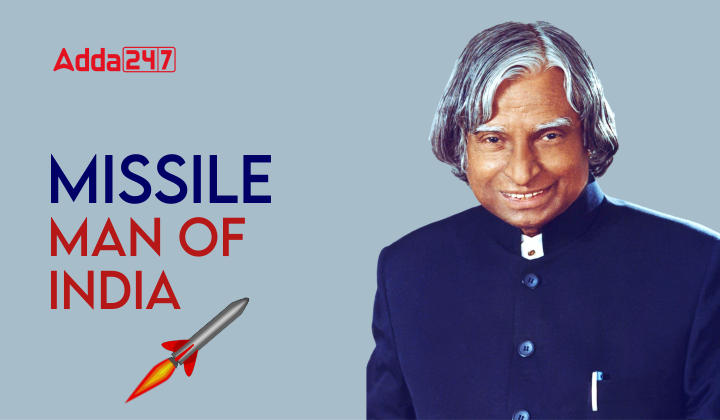In the realm of India’s scientific and technological legacy, a singular figure shines as a symbol of inspiration, creativity and unwavering commitment to the nation’s advancement: Dr. A.P.J. Abdul Kalam, fondly known as the “Missile Man of India.” His life and significant contributions serve as a radiant paradigm for future generations of Indians and the global scientific community, guiding the way toward success.
Missile Man of India: A.P.J. Abdul Kalam
Personal Details:
- Full name: Avul Pakir Jainulabdeen Abdul Kalam
- Birth date: 15th October, 1931
- Birth place: Rameswaram, Madras Presidency, British India
- Parents: Jainulabdeen Marakayar and Ashiamma
- Death: 27th July 2015
- Profession: Aerospace Scientist, Author
- Other name: Missile Man of India
- Field: Aerospace Engineering
- Position: 11th President of India
Early Life of A.P.J. Abdul Kalam
A.P.J. Abdul Kalam, born on 15th October 1931, in Rameswaram, Tamil Nadu, hailed from a humble Tamil Muslim family. His father was a boat owner and mosque imam, and his mother was a housewife. Despite ancestral affluence, the family faces financial hardship. Abdul Kalam even sold newspaper to help support the family.
Educational Life
Kalam, a diligent student, exhibited a strong thirst for knowledge. After completing his schooling, he pursued physics at St. Joseph’s College and graduated in 1954. He furthered his education at Madras Institute of Technology, where his resilience was evident when he met a project deadline facing scholarship loss.
Achievements of A.P.J. Abdul Kalam
Dr. A.P.J. Abdul Kalam, often referred to as the “Missile Man of India”, made significant contributions to various fields throughout his career. Here are some of his major achievements:
Early Career in Aerospace and Missile Development
Abdul Kalam started his career at the Defence Research and Development Organization (DRDO) and later joined the Indian Space Research Organization (IRSO). He played a crucial role in the development of India’s first satellite Launch Vehicle (SLV-III), which successfully deployed the Rohini Satellite in near earth orbit in 1980. He initiated projects like Project Devil and Project Valiant, which aimed to develop ballistic missiles using the technology from the SLV programme.
Missile Man
Kalam played a significant role in the development of India’s missile technology through the IGMDP (Integrated Guided Missile Development Programme). Due to this missile program, he earned the nickname “Missile Man.” Under this program, he led the development of missiles like Agni and Prithvi.
INCOSPAR Committee
Abdul Kalam was a part of the Indian National Committee for Space Reseach (INCOSPAR) committee working under Vikram Sarabhai, the renowned space scientists. The committee took over the responsibilities of the Department of Atomic Energy in space science and research.
Chief Scientific Advisor
Dr. Abdul Kalam was appointed as the scientific advisor to the Defence Minister in 1992. With the rank of a cabinet minister, he was appointed as the Principal Scientific Advisor to the Government of India in 1999. He also served as the chief scientific advisor to the Prime Minister of India.
India’s Nuclear Program
Kalam was involved in India’s nuclear tests, including the Pokhram-II nuclear tests in 1998. He served as the Chief Project Coordinator of the Pokhram-II nucleat test and played both a political and technological role in the tests.
Presidency of India
Dr. Kalam was elected as the 11th President of India in 2002, known as the “People’s President” due to his approachability and connection to the general public. During his presidency, he focused on inspiring youth and promoting education, particularly in the field of science and technology.
Educational Initiatives
After his presidency, Kalam continued to be involved in education and research. He served as a visiting professor at various prestigious institutions, including the Indian Institute of Management (IIM) campuses and Anna University.
Social Initiatives
Dr. Abdul Kalam launched the “What Can I Give movement” in 2012, aiming to instill values and encourage the youth to contribute positively to society.
Innovations
Dr. Kalam collaborated with cardiologist Soma Raju to develop the “Kalam-Raju Stent,” a low cost coronary stent to improve medical care accessibility. He also designed the “Kalam-Raju Tablet,” a rugged tablet computer for healthcare in rural areas.
Dr. A.P.J. Abdul Kalam’s contributions spanned various fields, from aerospace engineering and missile development to education, social initiatives and inspiring the youth of India. He left a lasting legacy as a scientist, leader and role model for generations to come.
Find More General Studies News Here



 Indian Olympic Medal Winners List Till N...
Indian Olympic Medal Winners List Till N...
 Who is the Inventor of the Gramophone?
Who is the Inventor of the Gramophone?
 HS Dhaliwal Appointed New DGP Of Andaman...
HS Dhaliwal Appointed New DGP Of Andaman...
